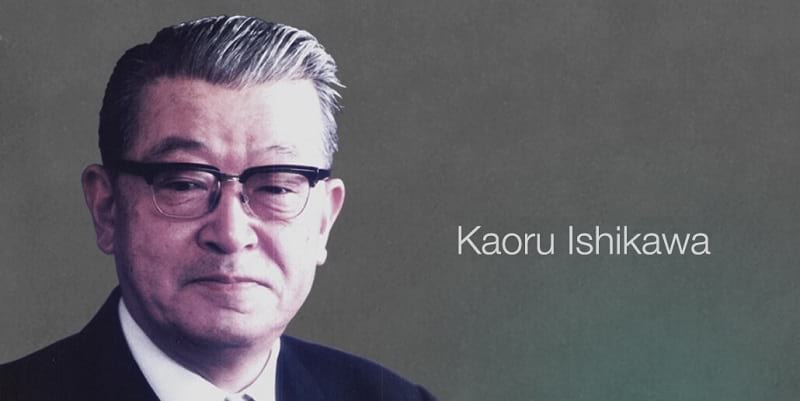Kaoru Ishikawa biography, quotes and books

Kaoru Ishikawa (1915 – 1989) was a Japanese professor, advisor and motivator with respect to the innovative developments within the field of quality management. This article contains his biography, books and quotes. Kaoru Ishikawa is best known for the development of the concept of the fishbone diagram, which is also known as the “Ishikawa diagram“. This type of root cause analysis is still used in many organizations for making diagnoses or taking concrete actions in which the root cause of the problem is identified.
Biography Kaoru Ishikawa
In 1939, Kaoru Ishikawa obtained his Master’s degree (MSc.) in applied chemistry from the University of Tokyo.
In 1960, Kaoru Ishikawa obtained his doctorate from the University of Tokyo. He obtained a doctorate (Ph.D.) in mechanical engineering with his doctoral thesis ‘Sampling of Coal’.
After he had completed his studies, Kaoru Ishikawa served in the Navy (1939-1941) and then joined Nissan Liquid Fuel Company. In the summer of 1945 Kaoru Ishikawa provided another ground breaking development and presented the first concept of the fishbone diagram. This problem solving model helps determine root causes of problems.
In 1947 Kaoru Ishikawa wanted to return to science and he started working as a professor at the University of Tokyo.
In 1949 Kaoru Ishikawa joined the Japanese Union of Scientists and Engineers (JUSE), a quality control research group.
After the Second World War, the economy and industrial sector changed in Japan. Kaoru Ishikawa met William Edwards Deming and Joseph M. Juran and together they developed various management concepts that integrated with the issues of the Japanese market.
In 1960 Kaoru Ishikawa introduced the concept of quality circles (a group of volunteers that meet to discuss and improve organizational performance), in association with JUSE. This concept was the beginning of an experiment to find out what effect the ‘leading hand’ (Gemba-cho) would have on quality.
Despite the fact that may organizations were approached to take part in the experiment, Nippon Telephone & Telegraph were the only enterprise that wanted to participate in this study.
The experiment was successful and quality circles became increasingly popular.
Quality circles are an essential part in the development of the concept of Total Quality Management (TQM).
As a result of the success of the experiment, the concept and the many articles and books that followed, Kaoru Ishikawa became more and more known within the world of scientific quality management.
Kaoru Ishikawa wrote 647 articles and 31 books in total, including the titles ‘Introduction to Quality Control’ (1954) and ‘What Is Total Quality Control? The Japanese Way’ (1985).
Kaoru Ishikawa Quotes
- “Think of at least four factors which influence your problem. See if a shift in one of these causes can give you a different effect to explore.”
- “Quality control starts and ends with training.”
- “Quality control is applicable to any kind of enterprise. In fact, Quality Control must be applied in every enterprise.”
- “The ideas of control and improvement are often confused with one another. This is because quality control and quality improvement are inseparable.”
- “In management, the first concern of the company is the happiness of people who are connected with it. If the people do not feel happy and cannot be made happy, that company does not deserve to exist.”
- “Quality control which cannot show results is not quality control. Let us engage in QC which makes so much money for the company that we do not know what to do with it.”
Books and Publications
- 2012, 1954. Introduction to Quality Control. JUSE Press.
- 1991. Guide to Quality Control. Asian Productivity Organization.
- 1985. What is Total Quality Control?. Prentice Hall.
- 1989. How to apply company-wide quality control in foreign-countries. Quality Progress, 22(9), 70-74.
- 1985. How to Operate QC Circle Activities. Tokyo: QC Circle Headquarters, Union of Japanese Scientists and Engineers.
- 1984. Quality Control Circles at Work, APO.
- 1984. Quality Control in Japan. Sasaki, The Japanese approach to production quality, Pergammon.
- 1984. Quality control circles at work: cases from Japan’s manufacturing and service sectors: with special contribution. Asian Productivity Organization.
- 1982. Quality control in Japan-company-wide quality control (CWQC). Japan Marketing-Advertising, 20, 4-8.
- 1981. Japanese quality control. Communications of the Operations Research Society of Japan, 26, 422-423.
- 1980. QC Circle Koryo : General Principles of the QC Circle. Tokyo: QC Circle Headquarters, Union of Japanese Scientists and Engineers.
- 1976. Total Quality Management. The Japanese way. Prentice.
- 1976. Guide to Quality Control, Asian Productivity Organisation. Hong Kong: Nordica International.
- 1974, 1976 en 1982. Guide to Quality Control.
- 1973. Product Liability, JUSE Press.
- 1969. Education and training of quality control in Japanese industry. Reports of Statistical Application and Research, JUSE, 16, 85-104.
- 1963. Cause and effect diagram. In Proceedings of International Conference on Quality. sn.
How to cite this article:
Van Vliet, V. (2013). Kaoru Ishikawa. Retrieved [insert date] from Toolshero: https://www.toolshero.com/toolsheroes/kaoru-ishikawa/
Original publication date: 08/02/2013 | Last update: 01/09/2024
Add a link to this page on your website:
<a href=”https://www.toolshero.com/toolsheroes/kaoru-ishikawa/”>Toolshero: Kaoru Ishikawa</a>











